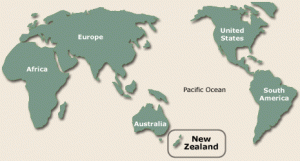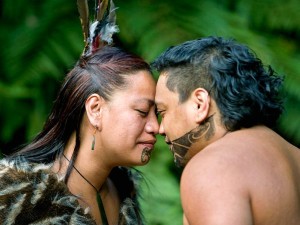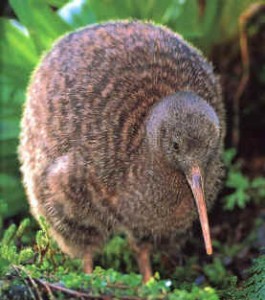Most people know little about New Zealand, apart from us Kiwis down here… many believe that we are somehow connected to Australia – by a bridge even. But we are not. We have a unique country with our own identity, our own culture.
The land mass of New Zealand is the creation of tectonic pressures, forcing up the edge of the Pacific Plate, as the Indo-Australian Plate plunges down toward the Earth’s fiery depths. The land mass, long and narrow, is called Aotearoa (aye-o-tey-a-row-a], Land of the Long White Cloud by the early inhabitants – the Maori. When they arrived, they became the first mammals other than a native bat to set foot on these shores. Up until this time, a unique and special ecosystem had developed.
Many resident species of bird and plant were found no where else on Earth. This, together with tall mountains, long and steep rivers and beautiful plains, make New Zealand adventure some of the best adventure there is…
Global location
 New Zealand is situated South East of Australia, and is about the size of Japan or the UK. It is between latitude 34’S and 47’S. The country runs north-south. About 40% of the country is very mountainous and protected by National Parks.
New Zealand is situated South East of Australia, and is about the size of Japan or the UK. It is between latitude 34’S and 47’S. The country runs north-south. About 40% of the country is very mountainous and protected by National Parks.
The people
There are almost 4 million New Zealanders, mostly of European descent. The mix of cultures is wide with immigrants from just about every continent on earth. The Maori people make up about 15% of the population and are reputed to have been the first to settle here about 1300 years ago. The first European to arrive was Tasman in 1642 who left quickly on account of a frosty reception by the well established Maori. Captain Cook, a Brit, was the next to arrive in the late 18th century and proved to be more resilient to the Maori welcome. He claimed New Zealand for Britain and was the first to map the country – and got most of it right!
With the coming of the Europeans, life for the Maori became very  unsettled. The European’s flu, which arrived with them, dealt the Maori a savage blow. Then with the land wars, it seemed like their race and culture might not survive. Despite a treaty signed with the English, land wars dominate most of the historical accounts of the late 19 century.
unsettled. The European’s flu, which arrived with them, dealt the Maori a savage blow. Then with the land wars, it seemed like their race and culture might not survive. Despite a treaty signed with the English, land wars dominate most of the historical accounts of the late 19 century.
Today, New Zealand is a peaceful country, and the people are harmonious. There is a strong national pride in the country. Sport is the common thread which links all the cultures together. And rugby is the king of all the sports in New Zealand.
The kiwi
New Zealanders are often referred to as ‘Kiwi’s’. The kiwi is a flightless bird about the size of a chicken. It has a long beak, and feeds mainly at night. The name comes from the cry it makes. The bird is one of New Zealand’s most endangered species and today, most sightings of the kiwi are of those in protection. Stewart Island, New Zealand’s third biggest Island, south of the South Island, is one place the kiwi can be relatively easily spotted in the wild.
of a chicken. It has a long beak, and feeds mainly at night. The name comes from the cry it makes. The bird is one of New Zealand’s most endangered species and today, most sightings of the kiwi are of those in protection. Stewart Island, New Zealand’s third biggest Island, south of the South Island, is one place the kiwi can be relatively easily spotted in the wild.
Seasons and climate
Being in the Southern Hemisphere, the seasons are the reverse of the Northern Hemisphere. Summer months are December, January and February where the average maximum temperature ranges from 20 to 30 degrees celsius, and about 15 to 20 degrees celcius in winter. The variation in temperatures is not extreme like some of the big continents. This is because New Zealand has a ‘maritime’ climate. Daylight hours are long in the summer time, darkness falls about 10pm and it’s light again by 6am – and the further South you head the longer the daylight lasts. In winter, the days are shorter, but the weather is often more settled, and in terms of sightseeing, winter can often produce the best vistas.